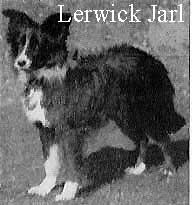
 THE ORIGINS OF THE BREED
THE ORIGINS OF THE BREED
To fully understand the origins of the Shetland Sheepdog, first of all we should get to know its native land, the Shetlands, nearly one hundred islands, of which 29 are inhabited, lying off the North coast of Scotland. One thousand five hundred squared km of an inhospitable land, wind swept and sea girt, with a really inhospitable weather.
Agriculture offers very little to the local people, a part from barley, oat and potatoes, therefore the main traditional resources to survive on the islands consists of fishery as well as ponies, cattle and sheep breeding. Shetland sheep have a high quality fleece, from which the finest wool is produced.
Meadows are on harsh lands, with steep rocks falling straight into the sea. What the shepherd wanted was a brave agile little dog, able to work on its own in all kind of weathers.
The shetland sheepdog was also traditionally called “toonie”. This nick-name comes from "toon”, a little land estate with a farm (croft) on it. Another graceful name for the sheltie was "peerie dog", from the word "peerie" that means "fairy".
Although the origins of the breed are definitelly uncertain, like otherwise for many other dog breeds, if we follow the history of its native land, and later on the events of the breed in Great Britain in XX century, we can certainly understand the main contributions that have brought us to have the modern sheltie.
The Vickings had a foundamental role in the history of any of the
North European countries, leaving on the colonized lands their coltural
heritage, and, together with their usages and customs, the
animals, specifically the dogs. In the IX century the Norse colonized
Iceland, Greenland and then The Shetlands (around 900 DC). 
From remains of dogs found in archeological excavations of Norse sites, it seems some dogs were similar to the Buhund, others with a longer body and shorter legs similar to the ancestor of the Valhund and of the Corgie.
It is anyway likely that Vikings brought on the Shetland coasts also the dogs from Iceland. The Iceland dog, of a spiz type, was used to heard sheep, ponies and cattle, which confirms the theory of the presence of this dog in the origins of the little shetland sheepdog. The sovereignty of the Shetland islands was ceded to Scotland in 1472, when the daughter of King Christian I of Norway and Danemark got married to James III of Scotland.
The treaty stated that usages and customs, in particular the commercial
rules, would remain unchanged. This assured a long and flourishing
period for trades with Scandinavian countries and their colonies, which
brought a positive and continuous enrichment of the genetic
pool of the shepherd dogs. At the end of 16th century, the control
of the Shetlands went to the Scottish bishop of Holyrood, who introduced
the strict Scottish laws and all trades with Scandinavian countries
ended, bringing a long period of cultural and economical isolation
for the islands.  The
consequence on animals, sheep and dogs, was undoubtly negative,
in fact, with the impoverishment of the genetic pool, both sheep and
dogs became rather smaller.
The
consequence on animals, sheep and dogs, was undoubtly negative,
in fact, with the impoverishment of the genetic pool, both sheep and
dogs became rather smaller.
It is gathered by documentary evidence the import of new sheep from Scotland in the second half of 18th century, and with the new shee, some new Scottish sheep dogs arrived on the islands.
The Scottish sheep dogs, originally had been rather big, as they had to defend sheep from wolves and bears. They probably descended from Persian sheepdogs, brought by Celts and later by Romans. From the second half of the 16th century, wolves disapeared, therefore a big shepherd dog was no longer necessary.
The sheep dog of the Shetlands, which was almost
a small spitz, was then crossed to these new sheep dogs. The dogs work
was still the same, hearding the sheep, keeping them on their piece
of land or bringing them from one pasture land to another one.  Like
in the modern sheltie, the temperament was rather reserved towards
strangers, which is natural for a sheep dog.
Like
in the modern sheltie, the temperament was rather reserved towards
strangers, which is natural for a sheep dog.
From some pictures of the working dogs on the Shetland islands in 19th century, it appears that shelties had shorter heads and somehow they were similar to little border collies, their most popular colour was black and white, although some farmer preferred black and tan. The dogs didn't have the same abundant coat of today's dogs, which would probably be no good for a working dog living in a damp cold weather.
The modern shetland comes firstly from these working dogs, which were exported to the Mainland at the beginning of XX century, but it is proved that some rough collie blood was used on the way. Miss Humphries, kennel Mountfort used a little collie bitch called Teena, which was then sold to Mr JimSaunders, kennel Helensdale. New collie blood was also used by Mr. Pierce, kennel Eltham Park. All this happened in the first twenty five years of the XX century. Somebody says that in other circumstances rough collies were used in shetland breeding, but this is not granted by documentary evidence.

 The collie cross was certainly useful to fixy the type, adding refindness, mainly in head expression, and improving some faults, for instance rounded skulls. On the other hand it has always been evident that shetland had to be different in type from the rough collie. Actually there had been some breeders who wanted the shetland to be a miniature collie, for instance the members of the “British Breeders Shetland Sheepdogs Association” with
Mr. Pierce as segretary, who had written a standard called “the
ideal collie in miniature”, but they were soon banned by the kennel club.
The collie cross was certainly useful to fixy the type, adding refindness, mainly in head expression, and improving some faults, for instance rounded skulls. On the other hand it has always been evident that shetland had to be different in type from the rough collie. Actually there had been some breeders who wanted the shetland to be a miniature collie, for instance the members of the “British Breeders Shetland Sheepdogs Association” with
Mr. Pierce as segretary, who had written a standard called “the
ideal collie in miniature”, but they were soon banned by the kennel club.
Today's UK standard was approved in 1986, and is the sixth version, since the breed was officially recognized. By reading the standard, there is no doubt that the type of the shetland sheepdog and the collie are different, therefore it is totally inapropriate the statement for which the sheltie is a collie in miniature.
maremma sheepdogs and shetland sheepdogs
Kennel di Selvaspina - loc. Casette, 26 - 37023 Grezzana - Verona - Italy / tel-fax +39 045 908606